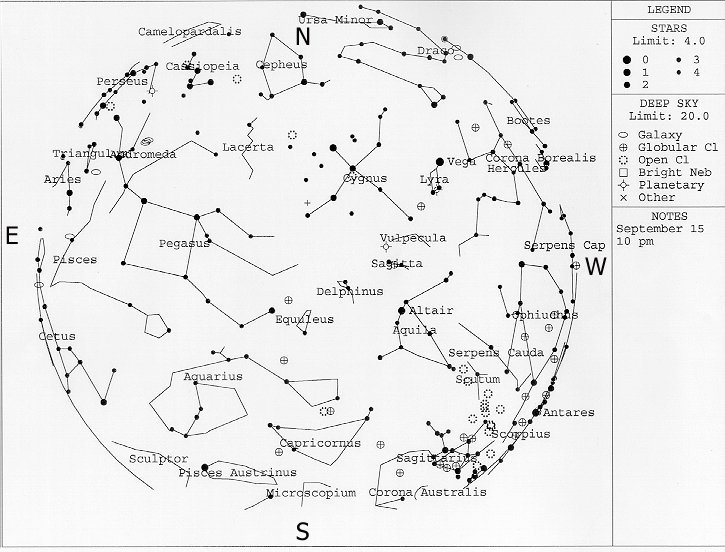What's to see in the night sky in September?

This chart represents the sky as it looks at around 10 PM local
time. Some adjustment should be made for longitude, but it shouldn't be much. Right click on
the chart, select "Save As" and save the image. You can then print
this chart from a photo application, like Print Shop Pro, hold it in front of you with the
direction you are facing at the bottom. Then, raise it above your head and you should be
able to find your way around from there.
=====================================================================
Moon Phases
New-9/8_____First Quarter-9/14____Full-9/23____Last Quarter-9/1
Planets
Mercury is in the morning sky late in the month. Greatest elongation favors northern observers on 9/19.
Venus is still high in the west after sunset. It's brightest on the 23rd. Crescent Moon occults Venus on 9/11, but is visible in southern hemisphere.
Mars is quickly disappearing into the Sun, but you can catch it early after sunset if you're patient.
Jupiter rises mid evening and is visible all night. Catch him within a degree of Uranus on 9/21.
Saturn disappears behind the Sun early in September and crosses to the south of the ecliptic on 9/8 where it will stay for the next 15 years!
Meteor showers
Delta Aurigids peak at 10 ZHR on 9/8.
Deep Sky Objects (DSO's)
Messier Objects
Globulars M2, 15, 30, 72 and 75, the best being M2 and 15. Both are right around 6.5
magnitude and large enough to see in binoculars. M29, 39 and 73 are open clusters, with 29
and 39 in being the only ones really worth a look. (M72 is only 4 stars in Capricornus.)
Both are fairly large, with M39 having more stars and more of a distribution of magnitudes.
I'd call it "interesting and fairly rich".
Strictly speaking, there are no PN's visible
from Messier's catalog, but no one will squawk if you sneak another peek at M27 again. :-)
Named DSO's
The most obvious named DSO's up now are the Veil Nebula-a supernova remnant in Cygnus, the
North American Nebula-an emmision nebula, also in Cygnus, the Pelican Nebula-right next to
"Florida", and the Crescent Nebula-a reflection nebula that looks like part of a PN, but isn't,
the star involved is known as a "Wolf-Rayet" star, which is basically a very high energy
emmitting star that's lighting up the gas around it.
Actually, the whole area around
Gamma Cygni, the center star in the "cross", is rich with open clusters, dark and bright nebulae
and is a wonderful place to go "binocular surfing". Enjoy!
Here's the link to SEDS as promised.
| January's page | February's page | March's's page | April's page | May's page | June's page |
| July's page | August's page | September's page | October's page | November's page | December's page |

Copyright 1999, Steve Dodder
Webmaster: Steve Dodder
Revised: 7/20/10